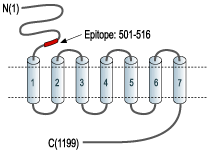Overview
- Peptide (C)HEGVLNIDDYKIQMNK, corresponding to amino acids 501-516 of rat mGluR1 (Accession P23385). Extracellular, N-terminus.

 Multiplex staining of mGluR1 and TRPC3 in mouse cerebellumImmunohistochemical staining of perfusion-fixed frozen mouse cerebellum sections using Anti-TRPC3-ATTO Fluor-594 Antibody (ACC-016-AR), (1:60) and Anti-mGluR1 (extracellular)-ATTO Fluor-488 Antibody (#AGC-006-AG), (1:60). A. TRPC3 staining (red). B. mGluR1 staining (green). C. Merge of the two images suggests extensive co-localization in Purkinje cells (vertical arrows). Note expression of mGluR1 in Purkinje dendrites (horizontal arrow) but not of TRPC3. Cell nuclei are stained with DAPI (blue).
Multiplex staining of mGluR1 and TRPC3 in mouse cerebellumImmunohistochemical staining of perfusion-fixed frozen mouse cerebellum sections using Anti-TRPC3-ATTO Fluor-594 Antibody (ACC-016-AR), (1:60) and Anti-mGluR1 (extracellular)-ATTO Fluor-488 Antibody (#AGC-006-AG), (1:60). A. TRPC3 staining (red). B. mGluR1 staining (green). C. Merge of the two images suggests extensive co-localization in Purkinje cells (vertical arrows). Note expression of mGluR1 in Purkinje dendrites (horizontal arrow) but not of TRPC3. Cell nuclei are stained with DAPI (blue). Expression of mGluR1 in rat cerebellumImmunohistochemical staining of rat cerebellum frozen sections with Anti-mGluR1 (extracellular)-ATTO Fluor-488 Antibody (#AGC-006-AG) (1:20). Staining (in green) appears in cerebellar Purkinje cells (arrows) and in the molecular layer.
Expression of mGluR1 in rat cerebellumImmunohistochemical staining of rat cerebellum frozen sections with Anti-mGluR1 (extracellular)-ATTO Fluor-488 Antibody (#AGC-006-AG) (1:20). Staining (in green) appears in cerebellar Purkinje cells (arrows) and in the molecular layer.
- Kew, J.N. and Kemp, J.A. (2005) Psychopharmacology (Berl.) 179, 4.
- Ferraguti, F. and Shigemoto, R. (2006) Cell Tissue Res. 326, 483.
- Dhami, G.K. and Ferguson, S.S. (2006) Pharmacol. Ther. 111, 260.
L-Glutamate is the major excitatory neurotransmitter in the central nervous system. It operates through several receptors that are categorized as ionotropic (ligand-gated cation channels) or metabotropic (G-protein coupled receptors). The metabotropic glutamate receptor family includes eight members (mGluR1-8) that have been divided into three groups based on their sequence homology, pharmacology and signal transduction.
Group I of the metabotropic glutamate receptors includes the mGluR1 and mGluR5 receptors. The receptors present the typical G-protein coupled receptor (GPCR) signature topology: seven transmembrane domains with a large extracellular N-terminus and an intracellular C-terminus. The N-terminus domain of Group I receptors contains the glutamate binding site while the cytoplasmic C-terminus domain has an important role in the regulation of receptor activity through interactions with other proteins such as the Homer adaptor proteins.
mGluR1 and mGluR5 receptors signal through Gq/G11, that activates phospholipase C and ultimately produces an increase in inositol trisphosphate and cytosolic Ca2+. Additional downstream signaling pathways include the activation of PKC and modulation of Ca2+ and K+ ion channels. Activation of signaling pathways independent of G-proteins have also been reported.
mGluR1 is predominantly expressed in nervous tissue although expression in several non-neural cell types has also been described. In the brain it is highly expressed in the hippocampus, cerebellum, olfactory bulb and thalamus.
The mGluR1 receptor is involved in several physiological processes such as neuronal development, induction of long-term potentiation (LTP) and depression (LTD) as well as in pathological disorders such as brain trauma, chronic pain, Parkinson’s and Huntington’s disease.
Application key:
Species reactivity key:
Anti-mGluR1 (extracellular) Antibody (#AGC-006) is a highly specific antibody directed against the extracellular N-terminus domain of rat mGluR1. The antibody can be used in western blot and immunocytochemistry applications, and recognizes mGluR1 in rat, mouse and human samples.
Anti-mGluR1 (extracellular)-ATTO Fluor-488 Antibody (#AGC-006-AG) is directly labeled with an ATTO-488 fluorescent dye. ATTO dyes are characterized by strong absorption (high extinction coefficient), high fluorescence quantum yield, and high photo-stability. The ATTO-488 label is analogous to the well known dye fluorescein isothiocyanate (FITC) and can be used with filters typically used to detect FITC. Anti-mGluR1 (extracellular)-ATTO Fluor-488 Antibody has been tested in immunohistochemistry applications and is especially suited for experiments requiring simultaneous labeling of different markers.
